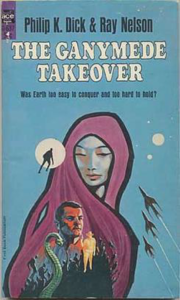“The Ganymede Takeover” (written in 1965, published in 1967) is in some ways a curious entry in Philip K. Dick’s catalog. Written with his longtime friend Ray Nelson, it’s one of only two collaborations (the other being “Deus Irae,” with Roger Zelazny).
Other than this book, Nelson’s biggest claim to fame is that John Carpenter adapted his 1963 short story “Eight O’Clock in the Morning” into the 1988 horror film “They Live.” “Takeover” is also a rare PKD novel that doesn’t have Vintage or Mariner editions, making it slightly more expensive (You can usually find a copy for around $15).
Return to Ganymede
In other ways, this is as Dickian as it gets. Ganymede, the largest moon of Jupiter and the solar system, was obviously among the author’s favorite orbs from which to imagine alien life has sprung. In “Takeover,” it’s not a friendly slime mold (as in “Clans of the Alphane Moon”) but instead a race of conquering worm creatures.
As with “The Man in the High Castle,” the story begins after the invasion; the Ganys are benign rulers of Earth, and several human characters hate themselves for surviving the war, taking it as proof that they didn’t do enough.
Without doing any background research, it’s not obvious what Nelson contributed, because the book feels very PKD. It is slightly more polished; the wild inventions aren’t as gleefully random as we’d expect, and they are sometimes explained more than usual.
For example, in chapter 12, a simulacrum is described as having “microminiaturized circuits.” I’d bet that’s a Nelson contribution, since PKD generally didn’t think in terms of tech devices getting smaller with time.
Flat characters
And the characters are slightly flat, behaving in quite mundane fashion amid their bizarre circumstances. Joan Hiashi is likely a stand-in for one of Dick’s ex-wives, but as seen through the eyes of several male characters, she is an indecipherable non-entity – described as “Nowhere Girl” at times.
Joan is unable to feel empathy. At first this manifests as Joan being a wik (“worm kisser”) who is going to turn on Percy X, the leader of a rare group of human holdouts (unfortunately called “Neegs”) – sort of like the Native Americans who were technically never conquered by the USA.
But after a love-hate sequence between Joan and Percy, she turns away from the world so much that her therapist later mistakes her simulacrum for the real thing, even though he invented the simulacrum.
Individualism vs. groupthink
Overall, “Takeover” feels like a solid B-game effort from Dick, especially when it explores the issue of individualism versus groupthink from various angles. Dr. Paul Rivers – the de facto main character, although he’s an observer more than a participant — outlines “Takeover’s” core theme in chapter 12:
Everyone says ‘we’ these days. Nobody says ‘I.’ Everyone represents some formless irresponsible group and nobody represents themselves.
Mekkis, assigned to govern Tennessee, is part of the Gany hive-mind, but he’s fascinated by the human concept of individuality. Joan is presumably at the other end of the spectrum, wanting to disappear into a group; she receives Oblivion Therapy from her doctor. After regular dunks in a sensory deprivation chamber, she becomes pliable and open to suggestion.

Amusingly, while Mekkis’ desire to be an individual strikes me as admirable — in the sense that it’s a human trait more than a Gany trait – it also means he has lost interest in his race’s best interests, and his job within the collectivist state.
The Ganys have found that having the buffer of a wik government between them and the human citizenry is the easiest way to rule Earth. So Mekkis is fine with having the wik hotel owner Gus lead the mission of wiping out Percy X’s Neegs.
Distracted by a library of Earth history books, Mekkis tells his secretary to give Gus whatever he asks for; soon, Gus has tons of weapons. In his readings, Mekkis didn’t get up to Jefferson’s warning about entangling alliances or Eisenhower’s warning about the military-industrial complex.
Worrying about the bomb
“Takeover” has the common PKD trait of being set after World War III, but in this case the bomb isn’t strictly of the past; it’s a present concern. But the bomb is presented metaphorically here, and it takes two forms.
A superweapon developed by the government but now in the hands of the Neegs makes people’s senses go wonky until they’ve lost their minds. Another (less well explained) superweapon is held by the Ganys; if humans prove too hard to control, they can use this weapon to kill all life on Earth, then take over the clean-slate planet.
The portrayal of black Americans in “Takeover” is extremely outdated even by 1967 standards. The “Toms” – blacks who don’t follow Percy X but are content to live as servants in white society – are barely removed from slavery. That’s an oddly regressive choice for a novel set in the future.
On the other hand, in chapter 16, Paul is hit by the sense-distorting weapon and imagines he is Joan. This is progressive, (probably) accidentally presaging the modern open-mindedness about gender identity. In this trippy sequence, Paul is himself, then he’s a generic woman, then he’s specifically Joan, then he’s back to his original self.
Of course, what Dick and Nelson are more likely going for here is a dive into the difference between feeling like an individual and feeling like a member of a group – and the pros and cons of both.
Extreme problems
Ultimately, the characters who are at one extreme or the other have the most problems and are the least happy. Those who are somewhere in the middle are well-adjusted, possessing a sense of self and an ability to understand where others are coming from.
Speaking of “somewhere in the middle,” that’s where “The Ganymede Takeover” ranks among PKD’s work. The novel’s exploration of self-identity in a tightly controlled world is effective, and readers who liked “High Castle” but wanted more SF in it can get it here.
But it’s less gonzo than his best work, making it technically crisper at times, but also making it less memorable.


